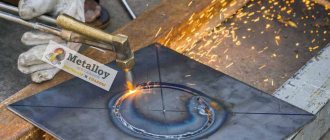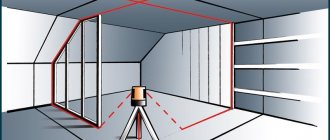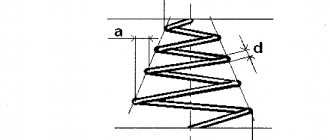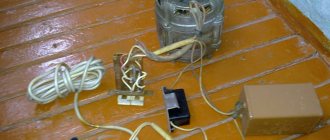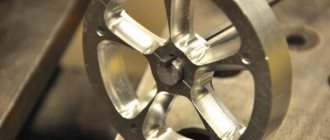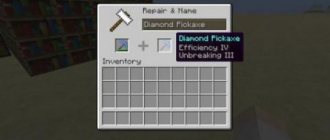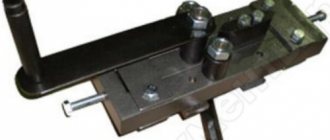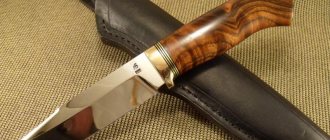Option 2 – get a job as a blacksmith’s apprentice
Some time ago, a letter was received from a site visitor about blacksmithing; it concerned training to become a blacksmith. Or rather, where to learn blacksmithing. It is clear that people are interested in forging and there are people who want to work as blacksmiths. That's why this article was written about where to find blacksmithing training. I think that my answer to the letter can help not only Andrey, but also everyone who wants to become a blacksmith.
I don’t have much time to write, so I’m quoting the correspondence.
Hello, Alexey Valerievich.
I really like working with metal, but unfortunately, it is very difficult to master this craft.
We have a big request for you - can you tell me where I can train as a blacksmith and master artistic forging? Do they accept students in this specialty?
Thanks in advance, best regards.
—
Andrey.
I'm glad that there are people who want to become blacksmiths. Answered:
Hello Andrei!
I received a letter from you with a question and am happy to answer.
Regarding training to become a blacksmith, if you are interested in a specific educational institution, then I can hardly help you, since I don’t even know where you live or in what region. But I’ll tell you a more practical way: find a forge in your area and try to get a job as a blacksmith’s apprentice. Even if it’s for a low salary. This is what I did 12 years ago and I don’t regret it. It's much more practical than learning theory. You can work with masters of their craft and learn various subtleties not only from their lips, but also by observing how they work.
- Blacksmith catalog here
And if there are no forges in your area (although then even more so, there are no educational institutions for forging) - then learn yourself, for example, with me on my website kovka-svarka.net. After all, I myself am mastering artistic forging at home, having some experience as an industrial blacksmith and very little experience in artistic blacksmithing. I write about my business on a blog, and skilled blacksmiths often come to my website and also share their experience.
Lord of Fire and Metal: Interview with a Master Blacksmith
A blacksmith can be a media person 
Angelina Brzhevskaya recently interviewed me about the secrets of the profession and more. I hope this story will be interesting to you too.
Lord of Fire and Metal
People of blacksmithing with hard work on a first-name basis. And their profession itself originated at a time when man became acquainted with fire and began to process iron. I was able to ask a few questions to a real blacksmith and learn amazing details about this profession. “Take risks, listen to yourself, not the advice of others. Everyone has their own path, the main thing is to try” - this is the life motto of master blacksmith Zelimkhan Evloev.
The profession of a blacksmith is very ancient. I know that at all times it was magical, and working with metal was equated with magic. The blacksmith was considered almost a shaman. What has changed during this time and where are they teaching blacksmithing now?
Ancient, yes. It is believed that the blacksmith profession originated in the 9th-7th centuries BC. during the Iron Age. But over time, people stopped being gullible and believing in magic, so now the “shamanism” of the blacksmith is in question (smiles).
Previously, not a single large village could do without a blacksmith, but now artistic forging is more an art than a necessity.
Therefore, there are not many places where blacksmithing is taught. This is either a college or an art university, where there is a specialty in “art metal processing”.
In order to become a blacksmith, there are three ways:
1. Go to school or institute;
2. Find an experienced blacksmith and persuade him to take himself on as an apprentice.
3. Or learn everything yourself. That’s how I studied blacksmithing—I took the third path.
From mythology, I only know Hephaestus as the maker of lightning for Zeus, but what other blacksmith gods are there?
This profession has always been “divine”. You correctly remembered the ancient Greek Hephaestus. But he is not the only one who forges lightning to milk the gods.
Among the ancient Slavs, lightning is forged by the thunder god Perun, and thunder during a thunderstorm is the sound of his hammer knocking on an anvil.
In Rus', it was believed that a blacksmith could eliminate evil spirits: in the epic, it is he who defeats the Serpent Gorynych, chaining him by the tongue. And there are also legends about how the heavenly forges, with the help of iron pincers, caught the terrible Lizard, harnessed it to a plow and plowed the ground.
Well, the Vikings have Volund. A very interesting journey “through the centuries” is associated with it. This blacksmith in Scandinavian mythology is a character in the Song of Volunda in the Elder Edda. In the Arthurian cycle of legends, he is credited with creating the sword Excalibur. It was Wölund, after the adoption of Christianity by the ancient Germans, who eventually turned into Satan, in the German pronunciation “Woland”. Let's remember Goethe's Faust. And from there he migrated to Bulgakov’s “The Master and Margarita”. Satan's lameness has the same roots as the lameness of Hephaestus and Volund. But we’ll leave this research for philologists.
Why blacksmithing? With your appearance, you should have gone into the modeling business. How did you even choose the profession of blacksmith and how long did you study it? Was there a temptation to give up everything and do something else? Or have you tried yourself in other areas of activity?
If all blacksmiths became models, our profession would die (laughs).
The profession is addictive, there really is a certain shamanism in it. The magic of metal, when a piece of iron turns into a new product, and you do it all, is a powerful thing. Imagine: hard metal in a forge heats up and becomes soft, you can sculpt what you want from it. And personally, I cannot refuse this. So there is no temptation to change profession and cannot be.
You asked why the blacksmith was considered a sorcerer. This is understandable when you think about the actual process of working in a forge. Just imagine what people of past centuries must have thought when the forges stood on the outskirts. This was done for completely prosaic reasons, to avoid the danger of fires. And many thought that miracles were happening there. People saw how a blacksmith, in flashes of flame, baled an anvil, and as a result, a new thing was born. Let it be even a simple horseshoe. But how it came out of a piece of iron is not easy for the uninitiated to understand.
It took me a long time to be called a blacksmith.
And I tried many professions - I worked in a workshop and was a realtor.
I came all the way from the “bottoms”. I started with a shovel, as they say, “take more - throw further.” Then there was welding, then “cold forging,” and only then the magic of hot metal.
What are the main tools of a blacksmith? How much does a hammer/sledgehammer weigh on average? The anvil is an important “part” of the forge. What does the most comfortable one look like?
The anvil is one of the three “basic” tools of a blacksmith.
It can be different and is sometimes called “scary” - for example, one-horned or two-horned. A true master “respects” his anvil very much, and its upper surface, on which the thing is forged, is called the “face”.
And, of course, one of the main assistants is a blacksmith’s hammer. Or rather, there are many of them - hammers and sledgehammers. A hammer can weigh differently - from 100 grams to 10 kilograms, and maybe more. Small hammers are used to make elegant products. The smaller the thing, the less metal is needed and the lighter the hammer.
The master is assisted in the forge by an apprentice - a hammer hammer, who performs the most difficult physical work. Now the hammer has been replaced by a pneumatic forging hammer.
No less important for the farrier are pliers. The god of the ancient Slavs, Svarog, when he taught a man how to forge, sent him blacksmith’s tongs to earth. And this is not accidental, since it is impossible to remove a red-hot piece of iron from the fire with your bare hands. And pliers, in fact, are an extension of the master’s hand; they allow him to perform various operations with heated metal, forging while it’s hot.
There are no convenient or inconvenient tools. Each type of the same anvil exists for a specific type of work and the “specialization” of the blacksmith.
So, the village blacksmith forged hoes, rakes and horseshoes. The city blacksmith is more involved in artistic forging.
And there are also blacksmiths who make knives. And this is a special art.
It’s like one artist paints in oils, another paints in pastels, and a third paints in watercolors.
Which metal is easiest to work with? What is the temperature of the metal, and does a blacksmith work only with iron?
The easiest way to work is with metal that is soft, like plasticine (laughs). But seriously, a blacksmith must heat up any metal. Temperature from 300 to 1000 degrees and above.
It all depends on the grade of steel, which is what I mainly work with now. Most often this is ST3 steel. This is what is used for artistic forging.
Knife makers use other varieties; they are more “sharpened” on technological aspects.
Steel is an alloy of metals. Previously, blacksmiths worked with pure iron, but it is soft and bends easily. Therefore, steel has many advantages over “pure” iron.
Three main qualities of a blacksmith.
As with all crafts, I think it's a matter of love for what you do, patience and constant mastery.
As in any field, there is competition in blacksmithing. What is she like? I know that you make original things, create your own sketches. How does a customer choose you? And how do ideas, for example, for your work “Mistress of the Copper Mountain” come about?
There is competition, as in any business. But she is honest, because a person sees your things and decides who to order from. Although some people take it by price, and others by quality.
My products, even those made for myself, are examples for the customer. Although I try not to repeat myself and always make not an exact copy, but a variation of it.
I love unique things and that’s what I do.
If the customer also has imagination, it is easier and more difficult at the same time, because each of us has our own vision. And then the sketch is not always easy to coordinate. But it’s easier to work with sketches, especially if the person himself sends them.
By the way, I don't create detailed sketches, which is also a kind of problem. My works are born in the process of work, because the metal lays down in its own way.
In the case of the “Copper Mountain Mistress” loops, it was the customer who wanted forged lizards. But simple ones. And I finalized the idea, added a crown - and with one detail I turned the lizards into the Mistress of the Copper Mountain.
Approximately the same thing happened recently with a forged shelf. I turned it back and forth in my head and came up with two hanging options - it can be mounted on the wall in different ways.
Do you have your own style? What is he like?
I like things that are functional, not just pretty. My style and operating principle is “decor plus utility.”
Most of my works are made in the classical style, although I myself prefer brutal forging. Now I am building my own estate, and there I will “have a blast” in this style.
What do they mostly order from you?
Almost all forged interior and exterior items - from candlesticks to gates. Plus forging in a historical, let’s say, style for reenactors, and from this category I like Viking shields the most. In general, I love the early Middle Ages and enjoy working with such things. Here I have to be not only a blacksmith, but also a carpenter - I make the wooden base of the shield myself, and then forge it. Although, when making forged tables, I work with wood - I make oak tabletops and, sometimes, I burn them with Lichtenberg lightning. It turns out to be a very beautiful pattern.
Can a blacksmith restore metal and how?
Restoring metal products was the main task of the village blacksmith. Replacing teeth in harrows, forks, rakes, repairing scythe blades and knives and axes - that's what he did most often. Replacing teeth, in short, is done like this: the old tooth is removed and a new one is installed - it is riveted, that is, the rivet tightens the metal.
I myself love restoring old things - for example, replacing the handles of vintage knives and returning the perfect “bow” to an old candlestick. In the first case, I forge a new handle, and in the second, I clean the metal, paint it and restore some parts.
The most unusual order you've ever made. How much time do you spend in the workshop? And how long does it take to make an original piece?
The most unusual order recently, perhaps, was a copper hood in the steampunk style, and in its “Victorian” branch.
Before this, I hadn’t really worked in steampunk, but here it was the customer’s wish, and I liked the result.
I have now made a fire bowl for myself - an outdoor fireplace, only not Victorian steampunk, but almost Viking, but with brutal chains and rivets.
In steampunk, old parts from used mechanisms are used. They are put in perfect order and become part of the art object, so to speak. Right now I’m making a table at the intersection of steampunk and loft styles from wood and four wheels. Two are from old industrial carts, and two larger ones are from some kind of Soviet agricultural machinery.
When there is an interesting order, you want to see the result quickly, but spending a day in the workshop is not an option...
We have already talked about what you like about your profession, but what infuriates you about it?
I'll be honest - these are amazing customers. They don’t come across often, but they take a lot of nerves. Communication with people is one of the biggest challenges, as in any profession that involves working with customers or customers.
For every ten reasonable people there will be one eccentric.
Therefore, I switched to producing ready-made works and do not install them.
How do you find customers or how do they find you?
Now everyone is on the Internet. The first thing everyone does is look online for contacts and products they want to buy. I myself do not have time to participate in exhibitions, and I am developing my presence on the Internet.
I have accounts on social networks, but the main thing is that there is an “Old Forge” page on the “Masters Fair” website. This is where customers and designers see me.
Plus, lately I’ve been developing a project with Vikings that was unexpected for many of my friends.
Option 3 – self-taught
If the first and second options do not suit you, are undesirable or impossible, then there is a third option - learn yourself from books and the Internet.
In fact, making a forge is not difficult. If you wish, you can forge something by setting up a place in a garage, barn, under a canopy, or just in the open air, if you wish. See the forge section here. If you have a dacha or a private house, then you can do forging in the yard. Make a forge, an anvil, get a hammer and go ahead. The blacksmith makes many devices himself, and you can make them with the help of this section about forging devices and this one about tools. If you have questions or doubts, ask, we will help with advice.
There is a lot of material on this topic on our website:
- The “Forging Training” section contains a lot of materials on the theory and practice of blacksmithing.
- The “How to forge” section examines in detail the production of specific forged products (tools and artistic forging).
- The section “Forging Operations” teaches the basics of blacksmithing from simple to complex.
If you want to learn forging yourself, equip a forge with your own hands, but are experiencing difficulties and uncertainty, then you can on this page and get an answer, advice and, possibly, consultation. The main thing is not to be afraid and do something.
By the way, here is a video below that shows what minimal things you need to try your hand at forging.
Features of the profession
The blacksmith's profession is one of the most ancient. Blacksmiths made tools, weapons, building elements, locks, and jewelry. They work with a wide variety of metals - from cast iron to gold. If necessary, a blacksmith can use not only forging, but also other technologies: forge welding, casting, forge soldering, heat treatment of products, etc. And yet forging is the main action in the work of a blacksmith. A large number of identical shaped products are often produced using stamping (hot or cold).
Another name for a blacksmith is a farrier. This word is borrowed from the Ukrainian language. In Soviet times, the word “koval” began to designate a separate blacksmith specialty. At the hippodromes there were farriers who were engaged exclusively in shoeing horses, and blacksmiths who made these horseshoes, i.e. worked in a forge with metal. The work of a farrier can be called intermediate between blacksmithing and veterinary medicine (veterinary orthopedics). But in the West, there is a similar division by specialty: farrier is a specialist who makes horseshoes for horses, blacksmith is a blacksmith as such, working in a forge, making horseshoes. Unlike Russian farriers, farriers in Europe and America must be able to make their own horseshoes, including complex and orthopedic ones. Recently, this trend has emerged in Russia.
